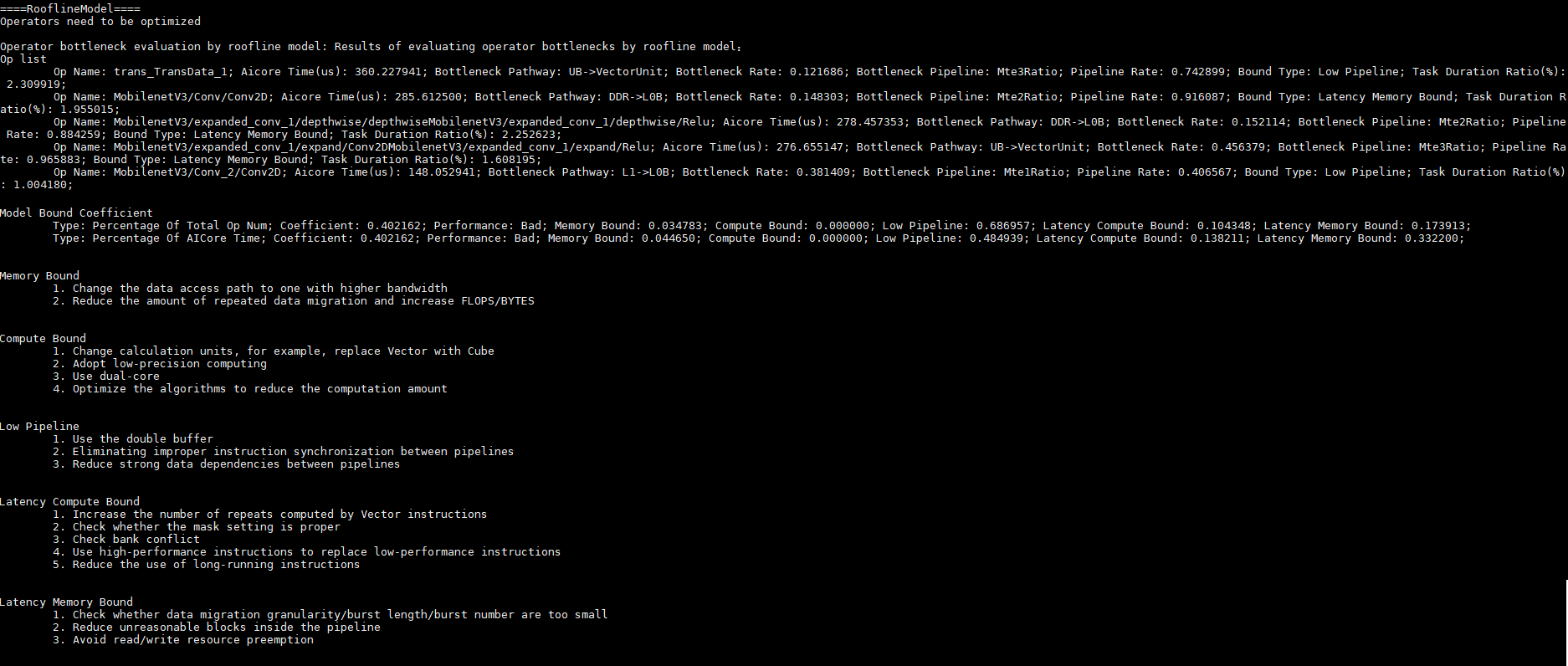该功能执行分析后通过Workload Analysis(比较工作点和屋顶的相对位置)输出分析结果。输出结果包括:
- Op list信息(列出所有工作在此区域的算子信息):
- 算子名
- 算子AI Core的时间占总AI Core时间的百分比(越大越有优化价值)
- 主要出现瓶颈的通道
- 距离当前的屋顶的百分比(比值越大表示越接近硬件上限瓶颈)
- 专家系统优化建议
输出结果如下:

输出结果是将存在瓶颈算子的基本信息以列表形式输出,并提供优化建议,优化建议内容如下:
|
输出建议 |
中文含义 |
|---|---|
|
Change the data access path to one with higher bandwidth |
更改数据访问通路,使用带宽更大的数据访问通路。 |
|
Reduce the amount of repeated data migration and increase FLOPS/BYTES |
减少数据重复搬移量,增大FLOPS/BYTES。 |
|
输出建议 |
中文含义 |
|---|---|
|
Change calculation units, for example, replace Vector with Cube |
更改计算单元,例如使用Cube替换Vector。 |
|
Adopt low-precision computing |
使用低精度计算。 |
|
Use dual-core |
使用双核计算。 |
|
Optimize the algorithms to reduce the computation amount |
优化算法,减少计算量。 |
|
输出建议 |
中文含义 |
|---|---|
|
Use the double buffer |
使用乒乓策略。 |
|
Reduce strong data dependencies between pipelines |
优化不合理的流水依赖。 |
|
Eliminating improper instruction synchronization between pipelines |
消除流水间不合理的指令同步。 |
|
Delete redundant pipe_barrier(PIPE_ALL). |
删除冗余pipe_barrier(PIPE_ALL)指令。 |
|
输出建议 |
中文含义 |
|---|---|
|
Increase the number of repeats computed by Vector instructions |
增大Vector指令计算的repeat数目。 |
|
Check whether the mask setting is proper |
检查mask设置是否合理。 |
|
Check bank conflict |
检查bank conflict。 |
|
Use high-performance instructions to replace low-performance instructions |
使用高性能指令替换低性能指令。 |
|
Reduce the use of long-running instructions |
减少使用运行时间长的指令。 |
|
输出建议 |
中文含义 |
|---|---|
|
Check whether data migration granularity/burst length/burst number are too small |
检查数据搬运粒度是否过小。 |
|
Reduce unreasonable blocks inside the pipeline |
减少流水内部不合理的阻塞。 |
|
Avoid read/write resource preemption |
避免读写资源抢占。 |
|
字段 |
说明 |
|---|---|
|
Percentage Of Total Op Num |
算子数量占比。 |
|
Percentage Of AICore Time |
AI Core耗时占比。 |
|
Coefficent |
瓶颈系数,所有算子的加权平均。 |
|
Performance |
性能优劣,取值为Good/Bad,瓶颈系数Coefficient大于0.8为Good,小于0.8为Bad。 |
|
Memory Bound |
内存瓶颈。 |
|
Compute Bound |
计算瓶颈。 |
|
Low Pipeline |
低流水利用率。 |
|
Latency Compute Bound |
潜在计算瓶颈。 |
|
Latency Memory Bound |
潜在内存瓶颈。 |
